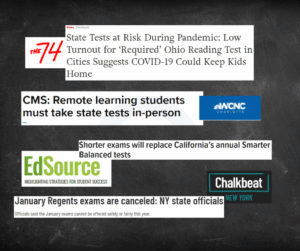By Dale Chu

California just shortened its annual test for next spring. New York has canceled its January round of Regents exams (standardized tests in core high school subjects). And with the virus resurging, the prospect of low student turnout is causing concern in states like Ohio and North Carolina, where one parent reportedly had this to say when she was told she had to send her eighth-grader to school for in-person testing:
“Make me. I’m very high risk, and I’m a single parent and don’t want to leave my child without a mother.”
To test or not to test? That is the question. The Biden administration will have their hands full in trying to safely reopen schools, but the decision of whether to issue another round of testing waivers adds a layer of complexity to an already taxing situation. So far, Biden’s team has been circumspect about the issue, but the question may already be out of their hands—at least when it comes to 2021.
There’s no other way to put it: The coronavirus is spiraling out of control and the outgoing administration is asleep at the wheel. What this means for schools is not encouraging. As long as students struggle to engage with online learning, it’s hard to envision a scenario where a majority, let alone 95 percent, of students are able to be in school to take state tests next spring.
To be sure, being able to take the test is just one piece of a larger issue, which is that distance learning is falling short too often for too many students, especially those from our most marginalized communities. The multi-pronged challenge is being able to improve online learning as fast as possible while simultaneously figuring out how to get kids back to class and to assess the extent to which many have fallen behind. Without standardized testing, states will not have an accurate and reliable way to measure and compare how students have fared.
To the credit of assessment advocates, plenty of workarounds are being floated, such as administering the tests online or doing a sampling of students a la NAEP, but all of these proposed solutions include a non-trivial amount of unanswered questions. For starters, online testing features privacy and security hurdles while sampling creates issues if the students with the most need are unable or unwilling to participate. Perhaps more importantly, as the clock continues to tick, states are not making contingency plans.
What this means for annual testing is that all of us need to start thinking beyond this spring (i.e., Spring 2022, 2023, 2024). Through the trials and tribulations over the last nine months, we’ve learned that state assessment systems are contingent upon in-person instruction—which was okay until the pandemic hit. Now, the already cloudy future of state testing stands little chance of improving without a deeper reexamination of this dynamic along with other assumptions that have been blown up by this crisis.
